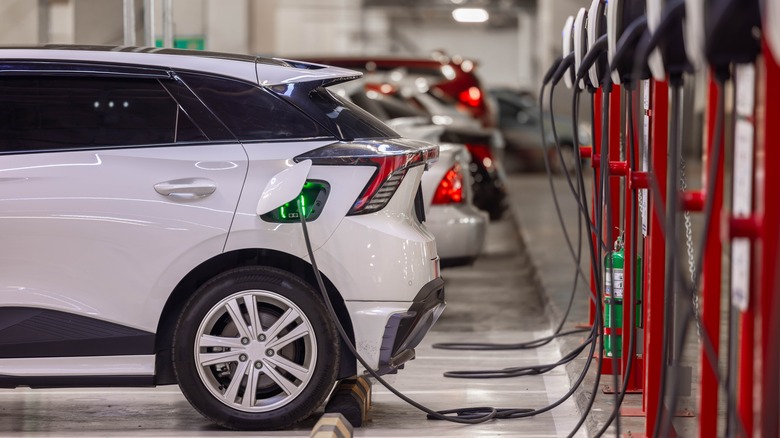How Much CO2 Does The Average Car Produce?
With climate change and global warming ravaging our planet, carbon emissions are one of the biggest modern concerns. Extreme weather and rising summer temperatures are the results of atmospheric changes due to carbon emissions, so it's natural to wonder what your personal impact is. Because vehicles are the most visible and obvious contributors to our individual carbon footprints, many want to know more about how much their vehicle contributes. Fortunately, you can also use the EPA's household carbon footprint calculator to estimate your entire carbon output.
The average car in the United States produces about 4.6 metric tons of carbon dioxide every year, according to the United States EPA, which focuses on passenger vehicles like sedans, SUVs, and pickup trucks. Of course, some cars emit less CO2 than others. An electric vehicle, for example, will produce much fewer carbon emissions than a gas-guzzling Hummer.
Relying on the EPA's average isn't a foolproof way to determine your own personal vehicle's CO2 emissions, either.The EPA concludes that an average passenger vehicle in the US will emit about 400 g of CO2 for every mile, but the global output is slightly different. In Europe, for example, yearly emissions for passenger cars have fallen in recent years to an impressive 108.2 g CO2/km, which is about 174.1 grams per mile.
Greenhouse gas emissions from gas-powered vehicles
The EPA's calculation assumes the average passenger vehicle achieves about 22.2 mpg while driving around 11,5000 miles per year and that drivers create about 8,887 g of CO2 for every gallon of gasoline burned. You can divide your average mileage per year by the average fuel economy, then multiply that value by the average amount of CO2 emissions per mile, and you'll get the total grams of CO2 a car produces per year:
- (11,500 miles per year) / (22.2 miles per gallon) x (8,887 grams of CO2) = 4,603,626 grams
Because a metric ton is 1 million grams, we arrive at a value of 4.6 metric tons of CO2 produced by a passenger vehicle per year.
If that seems like a lot, that's because it is. This isn't even to mention the other greenhouse gasses that gas-powered vehicles emit, such as methane and nitrous oxide. The production process of these vehicles also carries its own carbon footprint, including transportation costs, material extraction, parts manufacturing, and other carbon-emitting processes that often go unaccounted for.
Greenhouse gas emissions for hybrids and electric vehicles
Believe it or not, hybrid and electric-powered vehicles still produce greenhouse gas emissions, though it's overall less than gas-powered vehicles. For hybrids, the culprit is fairly obvious: These vehicles still burn fossil fuels, even if a portion of their power comes from electricity.
For electric vehicles, the biggest contributor to their carbon footprint is the production line. Extracting materials, transporting them, and assembling the vehicle requires energy. There's also the electricity itself, which is typically sourced from fossil fuel-burning plants. It's a hidden carbon footprint that often goes overlooked.
The U.S. Department of Energy provides a tool for looking up an electric or hybrid vehicle's greenhouse gas emissions. You'll have to enter your zip code to determine the source of the electricity charging your vehicle. Keep in mind that different parts of the country will use different fuel sources to produce electricity. This discrepancy makes a big distinction in an electric vehicle's carbon footprint since supplying electricity can be the difference between greenhouse-gas-heavy production and cleaner energy sources.
By the numbers, an EV battery emits as much as 100 Kg of CO2 per kilowatt-houron average. The source of that CO2 is based on the means of generating the electricity. After all, most electricity is produced from fossil fuels.
At the end of the day, hybrid and electric vehicles emit fewer greenhouse gasses than their fuel-burning counterparts. This is obvious when comparing total emissions, but you should still keep in mind that net CO2 production is far from zero.
The future of private vehicle carbon emissions
In the face of climate change caused by global warming, many governments are seeking to reduce the CO2 emissions of private vehicles through legislation. The European Union has enacted an aggressive new set of rules for gas-powered vehicles, with the goal of cutting greenhouse gas emissions from transportation by nearly half before 2030. The concept focuses on placing a price on carbon emissions, which falls within the category of a carbon tax.
Such initiatives can be seen in other places, as well, such as tax incentives for electric vehicles that encourage private owners to invest in EVs. This incentive can be found on the EPA website, which promotes what it calls green vehicles.
It seems that the future will see a decrease in CO2 emissions for private vehicles. However, it's important to remember that moving from gas-powered vehicles to electric vehicles won't necessarily eliminate your personal CO2 emissions. Most electricity in the United States (and the rest of the world, for that matter) is still generated from fossil fuels.



